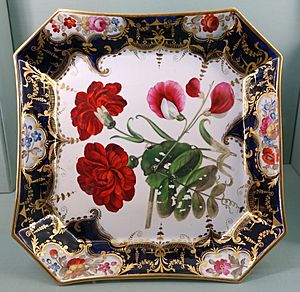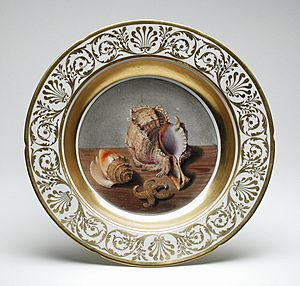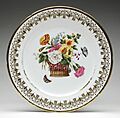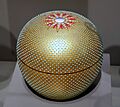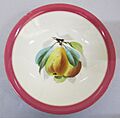Coalport porcelain facts for kids
Coalport was a famous place in Shropshire, England, known for making porcelain and pottery. This happened from about 1795 until 1926. The name Coalport porcelain is still used today for these special items.
The Coalport Canal opened in 1792, connecting to the River Severn. This made Coalport a great spot for factories. From 1800 to 1814, two factories worked there, one on each side of the canal. They made similar items, which can be hard to tell apart now.
These factories mostly made tableware, like plates and dishes. They often had fancy designs painted on top, especially flowers. In 1819, the factories joined together. They also got molds and skilled workers from other famous porcelain makers, Nantgarw porcelain and Swansea porcelain.
The Coalport factory was started by John Rose in 1795. He ran it very well until he passed away in 1841. The company often sold its items as Coalbrookdale porcelain. This was especially true for pieces with flowers that stuck out in 3D. People also called these items Coalport China.
What Coalport Made
John Rose hired William Billingsley, a talented painter, to be his main artist. Billingsley's chemist, Walker, also came to Coalport. He helped create a special maroon color for the porcelain. He also brought secret recipes from Nantgarw to Coalport.
Coalport and Coalbrookdale were very good at making dinner sets. They created the well-known "Indian tree" pattern. This design was actually based on Chinese art, not Indian. Many other British companies copied this pattern, and you can still find it today.
In the mid-1800s, Coalbrookdale copied designs from famous factories like Meissen porcelain and Manufacture nationale de Sèvres. They also made items with small, raised flowers, like vases, little boxes, and table baskets.
In 1820, John Rose won a gold medal from the Royal Society of Arts. He won it for his special feldspar porcelain and a new, lead-free glaze. This glaze made the colors blend perfectly when fired. Popular designs included the "worm sprig" and "Tournai sprig." They also made the "Berlin china edge" and the blue willow pattern and blue dragon pattern.
In the 1830s, the factory started a new method. They would print a light blue outline on the porcelain first. This helped guide the painters. It kept the hand-painted look but made production faster. Many other factories started using this method in the 1800s.
At the Great Exhibition in London in 1851, Coalport showed a fancy table service. It had deep blue borders. Queen Victoria had ordered it as a gift for Tsar Nicholas I of Russia.
Later in the 1800s, Coalport added another special skill. They developed a technique called "jewelling." This involved putting tiny beads of colored enamel onto the porcelain, often on a gold background. It's thought that the Worcester porcelain factory first developed this in the 1860s. Turquoise was a common color for these beads. They were carefully placed on tea sets, useful items, and decorative pieces. Often, they had rich, raised gold designs too. These items were sold in Britain and other countries.
How the Business Grew
The Coalport porcelain factory was the first porcelain factory in the Ironbridge Gorge. It was started by John Rose in 1795. Edward Blakeway helped him with money. John Rose had likely learned his skills at the Caughley porcelain factory, which was very close by. He had also been making pottery on his own since about 1793. In 1799, Rose took over the Caughley factory. He continued to make items there, at least the first stage, and then moved them to Coalport for decorating.
From 1800 to 1814, John Rose's brother, Thomas, ran a smaller factory. It was on the other side of the canal. He worked with William Reynolds and Robert Horton at first. After Reynolds passed away, his cousin Robert Anstice became a partner. John Rose's company took over their factory in 1814. In the same year, John Rose moved all the Caughley production to the Coalport site.
John Rose was very successful. This allowed him to buy the Nantgarw porcelain factory in 1819. He also bought the Swansea porcelain factory. This meant he got all their molds and designs.
John Rose passed away in 1841. His nephew, W.F. Rose, and William Pugh continued the business under the old name, "John Rose & Co." William Pugh became the only owner in 1862. After he passed away in 1875, the company faced financial trouble. In 1880, an engineer named Peter Bruff bought it. He renamed it the Coalport China Company.
His son, Charles Bruff, took over in 1889. He started selling many items to the United States and Canada in the 1890s. The factory buildings were rebuilt in 1902.
In the 1920s, the company had money problems again. It was taken over by Cauldon Potteries, Ltd., in 1925. In 1926, production moved to Staffordshire. This area was the main center for making ceramics in Britain. The Coalport name was still used as a brand. In 1967, the company became part of the Wedgwood group.
The original factory buildings are now home to the Coalport China Museum. There is also a YHA Youth Hostel, a cafe, and shops for artists and crafts.
Images for kids
-
A tall covered vase from about 1810, showing the factory and Coalbrookdale.
-
A floral centerpiece from about 1840, made of bone china. This type is often called Coalbrookdale porcelain.
-
A Diorama showing the Coalport site around 1820, at the Museum of the Gorge, Ironbridge.


